Week 30 - Aquatic Organisms are Affected by Many Factors
Completion requirements
Week 30 - Aquatic Organisms are Affected by Many Factors
Lesson 9
Read pages 381 - 384
Lesson 9: Populations
|
A population is the individual organisms of the same species living in the same place and at the same time
|
The leeches living in a prairie slough in 2002 forms a population. Members of populations of organisms compete with each other for food, space, and mates. The resources of the environment and how the organisms use these resources determine how large a population can be.
Populations
Most populations do not live in isolation. They live and interact with populations of other organisms.
|
Groups of populations that interact with each other in a given area form a community.
|
Populations of organisms in a community depend on each other for food and shelter and for other needs.
Within every habitat, communities of organisms exist in a close relationship to each other. Communities may be as small prairie pothole, as large as Lake Athabasca, or as complex as the intertidal zone along the rocky shore of one of British Columbia's Gulf Islands.
 |
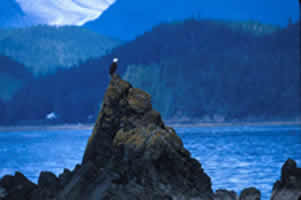 |
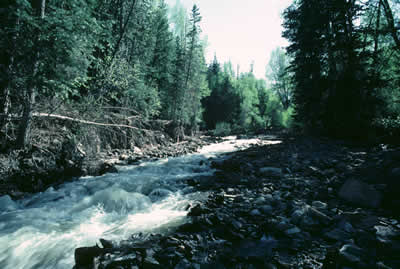 |
|
 |
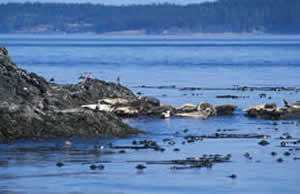 |
The relationships among species form a complex web. Some organisms produce food and others serve as prey. Some communities, such as the submerged vegetation along the shore of a marsh or slough provide both food and cover for the other organisms.
Change
Change is characteristic of ecological systems.
|
Living factors can cause change in communities
|
non-living factors can cause change in populations
|
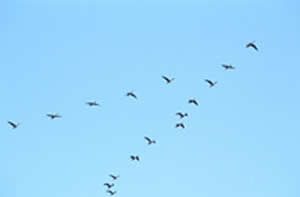 |
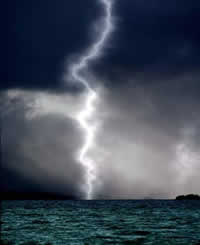 |
|
Germination of plant seeds, birth of animals, growth, movement and migration of animals affect the population size and composition of each community.
|
The temperature of the water, the amount of dissolved oxygen, and many other non-living factors can also have a dramatic impact on the population of plants and animals.
|
Some variations, such as seasonal changes, follow a predictable pattern. These are just a few examples of seasonal variations in the population size.
|
Birds
|
Salmon
|
Mosquito
|
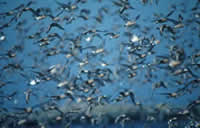 Large population of geese Large population of geese |
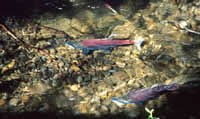 Young salmon in a river bed. Young salmon in a river bed. |
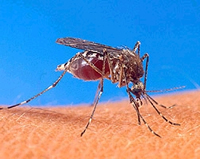 |
|
Every year, many species of birds migrate to the lakes and rivers of northern Alberta to breed. The population of these birds increases in the spring and decreases in the fall.
|
In coastal waters, salmon swim upstream to spawn. The population of salmon in the rivers is high at that time of year. However, after the old salmon die and the young salmon swim to the ocean, the population of salmon is dramatically lower
|
In the spring, mosquito eggs that have survived over the winter hatch and the larval stage of the mosquito emerges. The population of mosquitoes increases dramatically in the spring and summer and then drops to zero in the middle of winter.
|
Some communities are prone to rapid population fluctuations of one or more species. This is particularly true of tiny producers in aquatic ecosystems called plankton. Rapid changes in plankton diversity and abundance may occur hourly or daily to the interaction of biological, physical, and chemical factors.
Seasonal Change
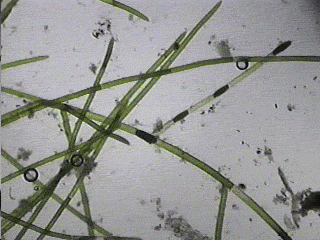
Many species exhibit long-term patterns in population abundance and distribution. For example, cutthroat trout suffer high mortality's during exceptionally warm weather. During summer, the temperature of water increases and the amount of dissolved oxygen decreases. Trout do not tolerate low levels of dissolved oxygen and many individual fish will die. The population of trout will slowly decrease over the summer.
Human Activities
Human activities also influence the size of different populations.
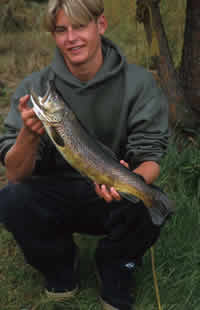
For example, over fishing will also reduce the population of trout in a river or salmon in the ocean.
Adding fertilizer to water systems provides additional nutrients for plankton. The result is an algae bloom. At first, you would think that having more algae would be good. More algae means more food and oxygen for aquatic animals. However, these organisms die and sink to the bottom of the lake or pond. As they decompose they use up valuable oxygen. The end result are low-levels of oxygen which can have a dramatic effect on other populations.
|
© 2002 Alberta Online Consortium
|
